PONTIAC GRAND PRIX 1998 Owners Manual
Manufacturer: PONTIAC, Model Year: 1998, Model line: GRAND PRIX, Model: PONTIAC GRAND PRIX 1998Pages: 402, PDF Size: 17.96 MB
Page 331 of 402

Grime from the windshield will stick to the wiper
blades and affect their performance. Clean the blade
by wiping vigorously
with a cloth soaked in
full-strength windshield washer solvent. Then
rinse the blade with water.
Check the wiper blades and clean them as necessary;
replace blades that look worn.
Weatherstrips
Silicone grease on weatherstrips will make them last
longer, seal better, and not stick or squeak. Apply
silicone grease
with a clean cloth at least every six
months. During very cold, damp weather more frequent
application may be required. (See “Recommended
Fluids and Lubricants” in the Index.)
Cleaning the Outside of Your Vehicle
The paint finish on your vehicle provides beauty, depth
of color, gloss retention and durability.
Washing Your Vehicle
The best way to preserve your vehicle’s finish is to keep it
clean by washing it often with lukewarm or cold
water.
Don’t wash your vehicle in the direct rays of the sun.
Don’t use strong soaps or chemical detergents. Use
liquid hand, dish or car washing (mild detergent)
soaps.
You can get GM-approved cleaning products from your
dealer. (See “Appearance Care and Materials” in the
Index.) Don’t use cleaning agents that are petroleum
based, or that contain acid or abrasives.
All cleaning
agents should be flushed promptly and
not allowed to
dry on the surface, or they could stain. Dry the finish
with a
soft, clean chamois or an all-cotton towel to
avoid surface scratches and water spotting.
High pressure car washes may cause water to enter your
vehicle.
Cleaning Exterior LampsLenses
Use lukewarm or cold water, a soft cloth and a liquid
hand, dish or vehicle washing
(mild detergent) soap to
clean exterior lamps and lenses. Follow instructions
under “Washing Your Vehicle.”
Finish Care
Occasional waxing or mild polishing of your vehicle by
hand may be necessary to remove residue from the paint
finish.
You can get GM-approved cleaning products
from your dealer. (See “Appearance Care and Materials”
in the Index.)
6-56
Page 332 of 402
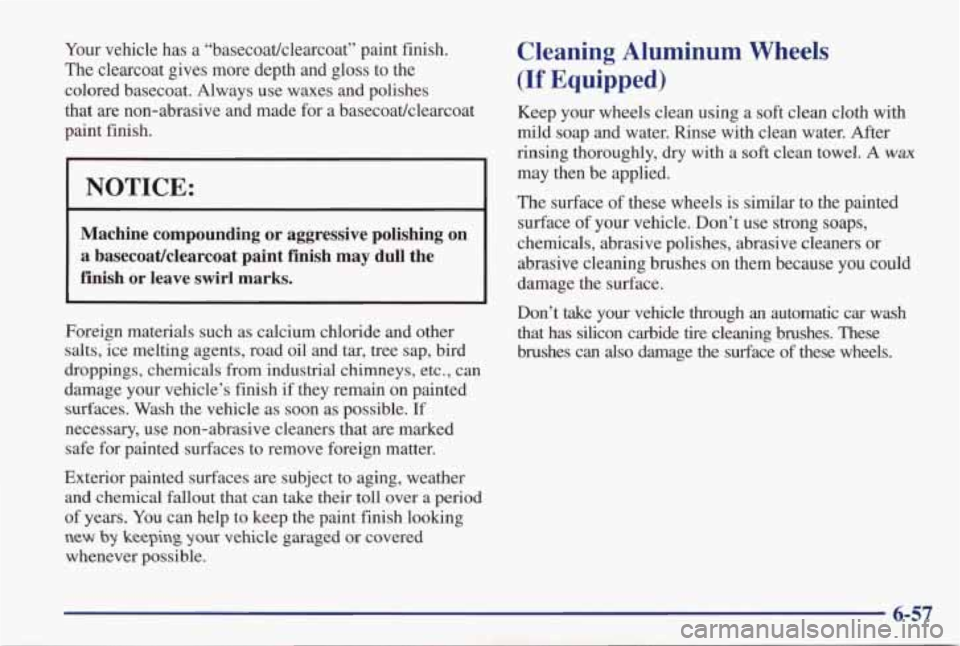
Your vehicle has a “basecoatjclearcoat” paint finish.
The clearcoat gives more depth and gloss to the
colored basecoat. Always use waxes and polishes
that are non-abrasive and made for a basecoatjclearcoat
paint finish.
I NOTICE:
Machine compounding or aggressive polishing on
a basecoat/clearcoat paint finish
may dull the
finish or leave swirl
marks.
Cleaning Aluminum Wheels
(If Equipped)
Keep your wheels clean using a soft clean cloth with
mild soap and water. Rinse with clean water. After
rinsing thoroughly, dry with a soft clean towel.
A wax
may then be applied.
The surface of these wheels is similar to the painted
surface
of your vehicle. Don’t use strong soaps,
chemicals, abrasive polishes, abrasive cleaners or
abrasive cleaning brushes
on them because you could
damage the surface.
Foreign materials such as calcium chloride and other
salts, ice melting agents, road oil and tar, tree sap, bird
droppings, chemicals from industrial chimneys, etc., can
damage your vehicle’s finish if they remain on painted surfaces. Wash the vehicle as soon as possible. If
necessary, use non-abrasive cleaners that are marked safe for painted surfaces to remove foreign matter.
Exterior painted surfaces are subject to aging, weather
and chemical fallout that can
take their toll over a period
of years. You can help to keep the paint finish looking
new by keeping your vehicle garaged or covered
whenever possible. Don’t
take your vehicle through an automatic car wash
that
has silicon carbide tire cleaning brushes. These
brushes can
also damage the surface of these wheels.
Page 333 of 402
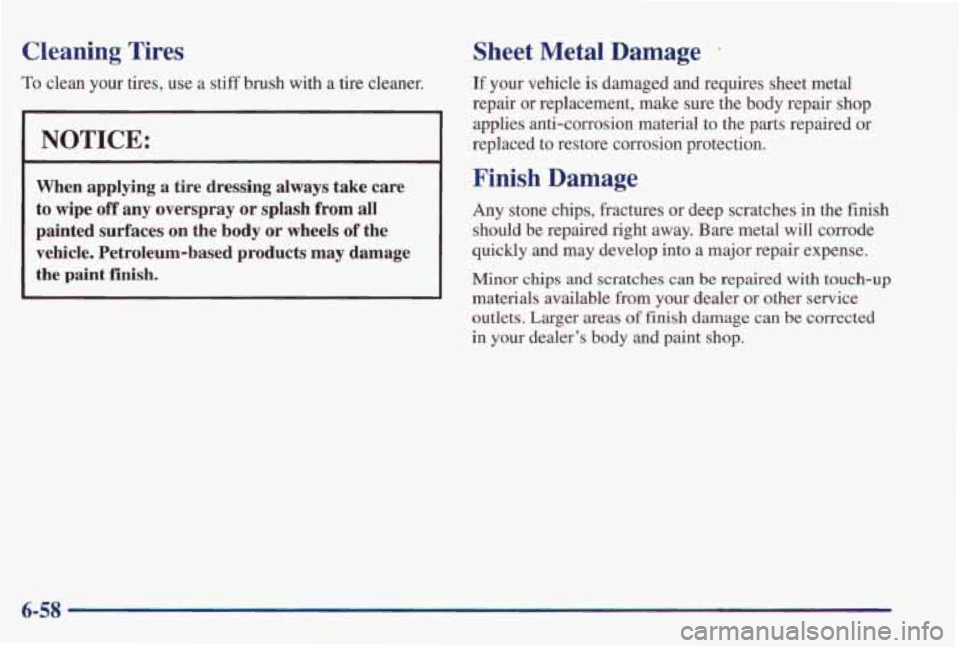
Cleaning Tires
To clean your tires, use a stiff brush with a tire cleaner.
NOTICE:
When applying a tire dressing always take care
to wipe off any overspray or splash from all
painted surfaces on the body or wheels of the
vehicle. Petroleum-based products
may damage
the paint finish.
Sheet Metal Damage
If your vehicle is damaged and requires sheet metal
repair or replacement, make sure the body repair shop
applies anti-corrosion material to the parts repaired or
replaced to restore corrosion protection.
Finish Damage
Any stone chips, fractures or deep scratches in the finish
should be repaired right away. Bare metal will corrode
quickly
and may develop into a major repair expense.
Minor chips and scratches can be repaired with touch-up
materials available from
your dealer or other service
outlets. Larger areas
of finish damage can be corrected
in your dealer’s body and paint shop.
Page 334 of 402
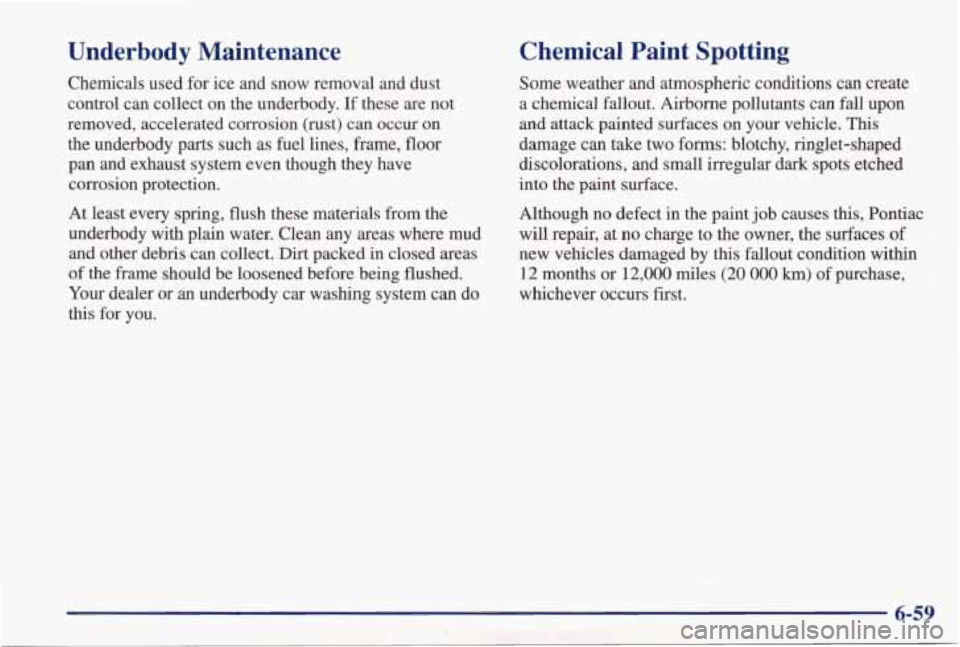
Underbody Maintenance
Chemicals used for ice and snow removal and dust .
control can collect on the underbody. If these are not
removed, accelerated corrosion (rust)
can occur on
the underbody parts such as fuel lines, frame, floor
pan and exhaust system even though they have
corrosion protection.
At least every spring, flush these materials from the underbody with plain water. Clean any areas where mud
and other debris can collect. Dirt packed in closed areas
of the frame should be loosened before being flushed.
Your dealer or an underbody car washing system can do
this for you.
Chemical Paint Spotting
Some weather and atmospheric conditions can create
a chemical fallout. Airborne pollutants can fall upon
and attack painted surfaces on your vehicle.
This
damage can take two forms: blotchy, ringlet-shaped
discolorations, and small irregular dark spots etched
into the paint surface.
Although no defect in the paint job causes
this, Pontiac
will repair, at no charge to the owner, the surfaces of
new vehicles damaged by this fallout condition within
12 months or 12,000 miles (20 OOO km) of purchase,
whichever occurs
first.
6-59
Page 335 of 402
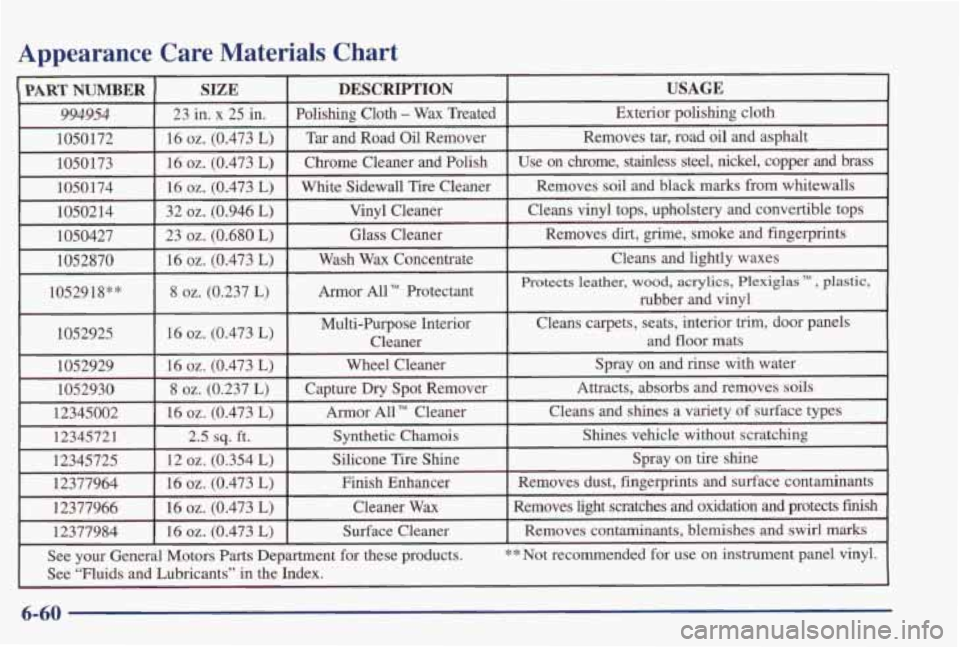
Appearance Care Materials Chart
6-60
Page 336 of 402
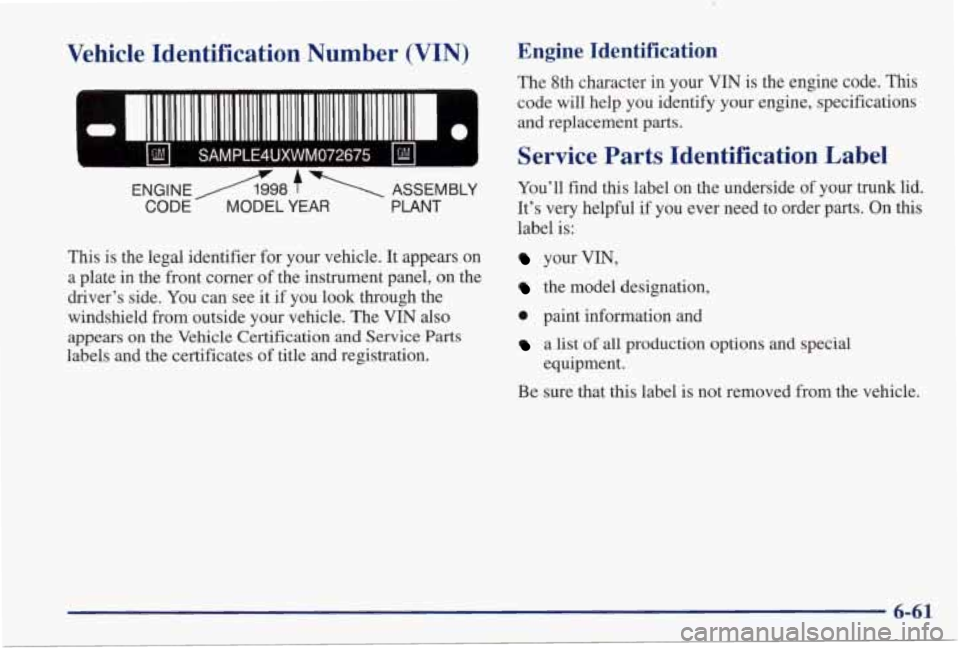
Vehicle Identification Number (VIN) Engine Identification
The 8th character in your VIN is the engine code. This
code will help
you identify your engine, specifications
and replacement parts.
Service Parts Identification Label
ENGINE/!& f ASSEMBLY You’ll find this label on the underside of your trunk lid. \
CODE MODEL YEAR PLANT It’s very helpful if you ever need to order parts. On this
label is:
This is the legal identifier for your vehicle. It appears on
a plate in the front corner of the instrument panel, on the
driver’s side. You can see it if you look through the
windshield from outside your vehicle. The VIN also
appears
on the Vehicle Certification and Service Parts
labels and the certificates of title and registration.
your VIN,
the model designation,
0 paint information and
a list of all production options and special
equipment.
Be sure that this label is not removed from the vehicle.
6-61
Page 337 of 402

Electrical System
kdd-On Electrical Equipment
NOTICE:
Don’t add anything electrical to your vehicle
unless you check with your dealer
first. Some
electrical equipment can damage your vehicle
and
the damage wouldn’t be covered by your
warranty.
Some add-on electrical equipment
can keep other components from working as
they should.
Your vehicle has an air bag system. Before attempting to
add anything electrical to your vehicle, see “Servicing
Your
Air Bag-Equipped Vehicle” in the Index.
Fuses and Circuit Breakers
The wiring circuits in your vehicle are protected
from short circuits by a combination of fuses, circuit
breakers, and fusible thermal links in the wiring itself.
This greatly reduces the chance of fires caused by
electrical problems.
Look at the silver-colored band inside the fuse. If the
band is broken or melted, replace the fuse. Be sure you
replace a bad fuse with a new one
of the identical size
and rating. Spare fuses are located
in the instrument
panel. See “Underhood Electrical Center” in the Index.
Headlamp Wiring
The headlamp wiring is protected by a circuit breaker in
the underhood electrical center. An electrical overload will cause the lamps
to go on and off, or in some cases
to remain off. If
this happens, have your headlamp
system checked right away.
6-62
Page 338 of 402

Windshield Wipers
The windshield wiper motor is protected by a circuit
breaker and a fuse.
If the motor overheats due to heavy
snow, etc., the wiper will stop until the motor cools.
If
the overload is caused by some electrical problem, have
it fixed.
Power Windows and Other Power Options
Circuit breakers in the fuse panel protect the power
windows and other power accessories. When the current
load is too heavy, the circuit breaker opens and closes,
protecting the circuit until the problem is fixed.
Instrument Panel Fuse Block
Some fuses are in a fuse block located inside of the glove
box behind a
small bin, on the right side. To open, pull on
the plastic strap
and pull the cover out. The fuse block is
inside.
On the back edge of this cover is a fuse puller and
a fuse usage chart. To use the fuse puller, place the wide
end
of the fuse puller over the plastic end of the fuse.
Squeeze the ends over the fuse and pull it out.
To reinstall the bin, position the lower end and turn
the top into position. Press on the sides until
it snaps
into place.
6-63
Page 339 of 402

FUSE USAGE CHART I See Underhood Electrical
Center For Spare Fuses I I I I
CIRCUIT BREAKERS
I HEADLAMP I
I I MAUPGM
STR WHL STR WHL
CTRL
I
I I PWR LOCK I I
RAP HAZARD ~
GIG LTR
I/P - IGN
CRUISE
ECM STOP LAMP
INT LAMP
ABS
PWR DROP MALL
WIPER
SUNROOF
CD CHG
AUWCNSL HVAC
HI PWR MIR
R DEFOG
HSEATILUM
RADIO
SIR TURN
BTSl
HVAC CTRL DlCRlVAC
I I I I CANISTER DRL VENT
rinted in USA.
For More Information, See Owner’s Manual 10401979)
Description
Circuit
Breaker
HEADLAMP
Headlamps
SEAT Power Seat, Power Lumbar
PWR WDO Power Windows
Fuse Description
MALL PGM Mall Module -- Program
MALL Mall Module
Fuse
WIPER
STR WHL
STR WHL
CTRL
SUNROOF
RADIO
PWR LOCK
HSEATLUM
R DEFOG
RAP
HAZARD
PWR MIR HVAC
HI
CIG LTR
INT LAMP STOP LAMP
Description
Wipers
Steering Wheel Illumination
Steering Wheel Control
Sunroof
Radio, Antenna
Mall Module
-- Power Locks
Heated Seats, Power Lumbar
Rear Defog
Retained Accessory Power, Mall Module
Hazard Flashers
Power Mirrors
HVAC Blower -- Hi
Cigarette Lighter,
ALDL, Floor
Console Auxiliary Outlet
Mall Module
-- Interior lamps
S toplamp
6-64
Page 340 of 402
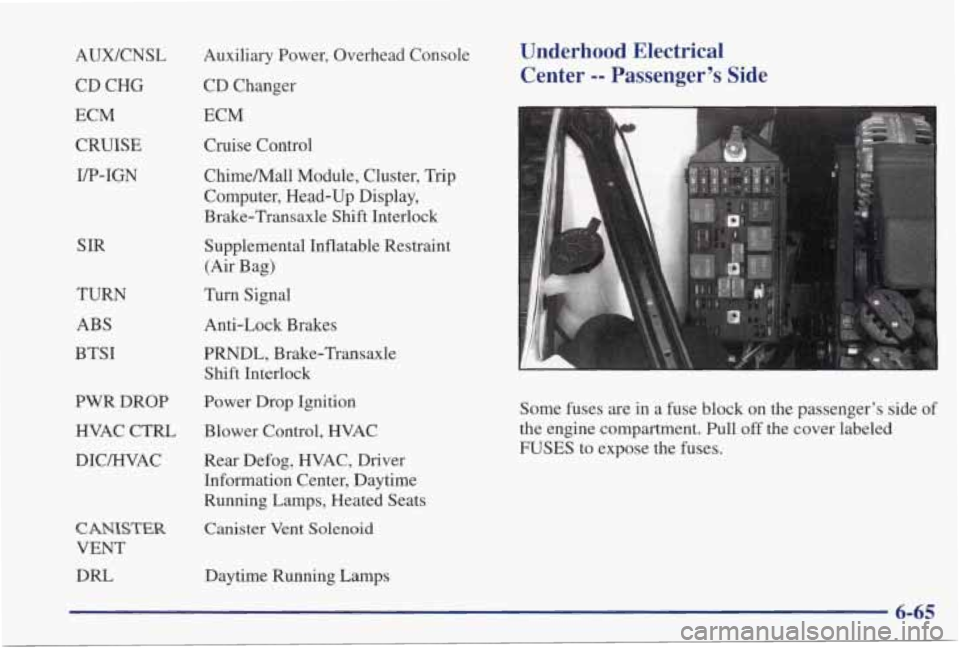
AUWCNSL CD CHG
ECM
CRUISE
UP-IGN
SIR
TURN
ABS
BTSI
PWR DROP HVAC CTRL
DIC/HVAC
DRL Auxiliary Power, Overhead Console
CD Changer
Underhood Electrical Center
-- Passenger’s Side
ECM
Cruise Control
ChimeNall Module, Cluster, Trip
Computer, Head-Up Display,
Brake-Transaxle Shift Interlock
Supplemental Inflatable Restraint
Turn Signal
(Air Bag)
Anti-Lock Brakes
PRNDL, Brake-Transaxle Shift Interlock
Power Drop Ignition
Blower Control, HVAC
Rear Defog, HVAC, Driver
Information Center, Daytime
Running Lamps, Heated Seats
Canister
Vent Solenoid
Daytime Running Lamps Some fuses are in a fuse block on the passenger’s side
of
the engine compartment. Pull
off the cover labeled
FUSES
to expose the fuses.
6-65